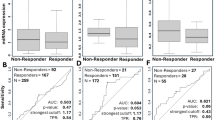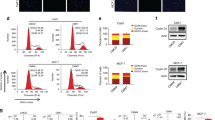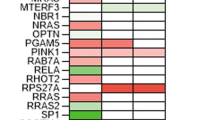Abstract
Resistance to chemotherapeutic treatment, which is indirectly responsible for many cancer deaths, is normally associated with an aggressive phenotype including increased cell motility and acquisition of invasive properties. Here we describe how breast cancer cells overcome doxorubicin-induced senescence and become drug resistant by overexpression of the microRNA (miR)-106b∼25 cluster. Although all three miRs in the cluster contribute to the generation of doxorubicin resistance, miR-25 is the major contributor to this phenotype. All three miRs in this cluster target EP300, a transcriptional activator of E-cadherin, resulting in cells acquiring a phenotype characteristic of cells undergoing epithelial-to-mesenchymal transition (EMT), including an increase in both cell motility and invasion, as well as the ability to proliferate after treatment with doxorubicin. These findings provide a novel drug resistance/EMT regulatory pathway controlled by the miR-106b∼25 cluster by targeting a transcriptional activator of E-cadherin.
Similar content being viewed by others
Log in or create a free account to read this content
Gain free access to this article, as well as selected content from this journal and more on nature.com
or
Abbreviations
- ALDH:
-
aldehyde dehydrogenase
- CSC:
-
cancer stem cell
- EMT:
-
epithelial–mesenchymal transition
- ESF:
-
primary human embryonic skin fibroblast
- MCM7:
-
minichromosome maintenance complex component 7
- MD60:
-
doxorubicin-resistant MTMEC
- miR:
-
microRNA
- MTMEC:
-
minimally transformed mammary epithelial cell
- SA:
-
senescence associated
- UTR:
-
untranslated region
References
Gottesman MM, Fojo T, Bates SE . Multidrug resistance in cancer: role of ATP-dependent transporters. Nat Rev Cancer 2002; 2: 48–58.
Raguz S, Yagüe E . Resistance to chemotherapy: new treatments and novel insights into an old problem. Br J Cancer 2008; 99: 387–391.
Szakacs G, Paterson JK, Ludwig JA, Booth-Genthe C, Gottesman MM . Targeting multidrug resistance in cancer. Nat Rev Drug Discov 2006; 5: 219–234.
Singh A, Settleman J . EMT, cancer stem cells and drug resistance: an emerging axis of evil in the war on cancer. Oncogene 2010; 29: 4741–4751.
Yagüe E, Arance A, Kubitza L, O'Hare M, Jat P, Ogilvie CM et al. Ability to acquire drug resistance arises early during the tumorigenesis process. Cancer Res 2007; 67: 1130–1137.
Minchinton AI, Tannock IF . Drug penetration in solid tumours. Nat Rev Cancer 2006; 6: 583–592.
Ewald JA, Desotelle JA, Wilding G, Jarrard DF . Therapy-induced senescence in cancer. J Natl Cancer Inst 2010; 102: 1536–1546.
Sliwinska MA, Mosieniak G, Wolanin K, Babik A, Piwocka K, Magalska A et al. Induction of senescence with doxorubicin leads to increased genomic instability of HCT116 cells. Mechanisms Ageing Dev 2009; 130: 24–32.
Kuilman T, Michaloglou C, Mooi WJ, Peeper DS . The essence of senescence. Genes Dev 2010; 24: 2463–2479.
Chang BD, Broude EV, Dokmanovic M, Zhu H, Ruth A, Xuan Y et al. A senescence-like phenotype distinguishes tumor cells that undergo terminal proliferation arrest after exposure to anticancer agents. Cancer Res 1999; 59: 3761–3767.
Chang BD, Xuan Y, Broude EV, Zhu H, Schott B, Fang J et al. Role of p53 and p21waf1/cip1 in senescence-like terminal proliferation arrest induced in human tumor cells by chemotherapeutic drugs. Oncogene 1999; 18: 4808–4818.
Jones KR, Elmore LW, Jackson-Cook C, Demasters G, Povirk LF, Holt SE et al. p53-Dependent accelerated senescence induced by ionizing radiation in breast tumour cells. Int J Radiat Biol 2005; 81: 445–458.
Chicas A, Wang X, Zhang C, McCurrach M, Zhao Z, Mert O et al. Dissecting the unique role of the retinoblastoma tumor suppressor during cellular senescence. Cancer Cell 2010; 17: 376–387.
Elmore LW, Rehder CW, Di X, McChesney PA, Jackson-Cook CK, Gewirtz DA et al. Adriamycin-induced senescence in breast tumor cells involves functional p53 and telomere dysfunction. J Biol Chem 2002; 277: 35509–35515.
Elmore LW, Di X, Dumur C, Holt SE, Gewirtz DA . Evasion of a single-step, chemotherapy-induced senescence in breast cancer cells: implications for treatment response. Clin Cancer Res 2005; 11: 2637–2643.
Reinhart BJ, Slack FJ, Basson M, Pasquinelli AE, Bettinger JC, Rougvie AE et al. The 21-nucleotide let-7 RNA regulates developmental timing in Caenorhabditis elegans. Nature 2000; 403: 901–906.
Calin GA, Dumitru CD, Shimizu M, Bichi R, Zupo S, Noch E et al. Frequent deletions and down-regulation of micro- RNA genes miR15 and miR16 at 13q14 in chronic lymphocytic leukemia. Proc Natl Acad Sci USA 2002; 99: 15524–15529.
Jang JS, Jeon HS, Sun Z, Aubry MC, Tang H, Park CH et al. Increased miR-708 expression in NSCLC and its association with poor survival in lung adenocarcinoma from never smokers. Clin Cancer Res 2012; 18: 3658–3667.
Calin GA, Sevignani C, Dumitru CD, Hyslop T, Noch E, Yendamuri S et al. Human microRNA genes are frequently located at fragile sites and genomic regions involved in cancers. Proc Natl Acad Sci USA 2004; 101: 2999–3004.
He L, Thomson JM, Hemann MT, Hernando-Monge E, Mu D, Goodson S et al. A microRNA polycistron as a potential human oncogene. Nature 2005; 435: 828–833.
Bonci D, Coppola V, Musumeci M, Addario A, Giuffrida R, Memeo L et al. The miR-15a-miR-16-1 cluster controls prostate cancer by targeting multiple oncogenic activities. Nat Med 2008; 14: 1271–1277.
Yang H, Kong W, He L, Zhao JJ, O'Donnell JD, Wang J et al. MicroRNA expression profiling in human ovarian cancer: miR-214 induces cell survival and cisplatin resistance by targeting PTEN. Cancer Res 2008; 68: 425–433.
Zhou M, Liu Z, Zhao Y, Ding Y, Liu H, Xi Y et al. MicroRNA-125b confers the resistance of breast cancer cells to paclitaxel through suppression of pro-apoptotic Bcl-2 antagonist killer 1 (Bak1) expression. J Biol Chem 2010; 285: 21496–21507.
Fang L, Deng Z, Shatseva T, Yang J, Peng C, Du WW et al. MicroRNA miR-93 promotes tumor growth and angiogenesis by targeting integrin-beta8. Oncogene 2011; 30: 806–821.
Ivanovska I, Ball AS, Diaz RL, Magnus JF, Kibukawa M, Schelter JM et al. MicroRNAs in the miR-106b family regulate p21/CDKN1A and promote cell cycle progression. Mol Cell Biol 2008; 28: 2167–2174.
Poliseno L, Salmena L, Riccardi L, Fornari A, Song MS, Hobbs RM et al. Identification of the miR-106b∼25 microRNA cluster as a proto-oncogenic PTEN-targeting intron that cooperates with its host gene MCM7 in transformation. Sci Signal 2010; 3: ra29.
Petrocca F, Visone R, Onelli MR, Shah MH, Nicoloso MS, de Martino I et al. E2F1-regulated microRNAs impair TGF[beta]-dependent cell-cycle arrest and apoptosis in gastric cancer. Cancer Cell 2008; 13: 272–286.
Smith AL, Iwanaga R, Drasin DJ, Micalizzi DS, Vartuli RL, Tan AC et al. The miR-106b-25 cluster targets Smad7, activates TGF-beta signaling, and induces EMT and tumor initiating cell characteristics downstream of Six1 in human breast cancer. Oncogene 2012; 31: 5162–5171.
Zhao JJ, Gjoerup OV, Subramanian RR, Cheng Y, Chen W, Roberts TM et al. Human mammary epithelial cell transformation through the activation of phosphatidylinositol 3-kinase. Cancer Cell 2003; 3: 483–495.
Agarwal R, Kaye SB . Ovarian cancer: strategies for overcoming resistance to chemotherapy. Nat Rev Cancer 2003; 3: 502–516.
Khongkow M, Olmos Y, Gong C, Gomes AR, Monteiro LJ, Yagüe E et al. SIRT6 modulates paclitaxel and epirubicin resistance and survival in breast cancer. Carcinogenesis 2013; 34: 1476–1486.
Barpe DR, Rosa DD, Froehlich PE . Pharmacokinetic evaluation of doxorubicin plasma levels in normal and overweight patients with breast cancer and simulation of dose adjustment by different indexes of body mass. Eur J Pharm Sci 2010; 41: 458–463.
Shi YK, Yu YP, Tseng GC, Luo JH . Inhibition of prostate cancer growth and metastasis using small interference RNA specific for minichromosome complex maintenance component 7. Cancer Gene Ther 2010; 17: 694–699.
Wang J, Tai LS, Tzang CH, Fong WF, Guan XY, Yang M . 1p31, 7q21 and 18q21 chromosomal aberrations and candidate genes in acquired vinblastine resistance of human cervical carcinoma KB cells. Oncol Rep 2008; 19: 1155–1164.
Dean M, Fojo T, Bates S . Tumour stem cells and drug resistance. Nat Rev Cancer 2005; 5: 275–284.
Morel AP, Lievre M, Thomas C, Hinkal G, Ansieau S, Puisieux A . Generation of breast cancer stem cells through epithelial-mesenchymal transition. PLoS One 2008; 3: e2888.
Awad O, Yustein JT, Shah P, Gul N, Katuri V, O'Neill A et al. High ALDH activity identifies chemotherapy-resistant Ewing's sarcoma stem cells that retain sensitivity to EWS-FLI1 inhibition. PLoS One 2010; 5: e13943.
Liang Y, McDonnell S, Clynes M . Examining the relationship between cancer invasion/metastasis and drug resistance. Curr Cancer Drug Targets 2002; 2: 257–277.
Betel D, Wilson M, Gabow A, Marks DS, Sander C . The microRNA.org resource: targets and expression. Nucleic Acids Res 2008; 36 (Database issue): D149–D153.
Liu YN, Lee WW, Wang CY, Chao TH, Chen Y, Chen JH . Regulatory mechanisms controlling human E-cadherin gene expression. Oncogene 2005; 24: 8277–8290.
Gal A, Sjoblom T, Fedorova L, Imreh S, Beug H, Moustakas A . Sustained TGF beta exposure suppresses Smad and non-Smad signalling in mammary epithelial cells, leading to EMT and inhibition of growth arrest and apoptosis. Oncogene 2008; 27: 1218–1230.
Zubeldia IG, Bleau AM, Redrado M, Serrano D, Agliano A, Gil-Puig C et al. Epithelial to mesenchymal transition and cancer stem cell phenotypes leading to liver metastasis are abrogated by the novel TGFbeta1-targeting peptides P17 and P144. Exp Cell Res 2013; 319: 12–22.
Bryan EJ, Jokubaitis VJ, Chamberlain NL, Baxter SW, Dawson E, Choong DY et al. Mutation analysis of EP300 in colon, breast and ovarian carcinomas. Int J Cancer 2002; 102: 137–141.
Gayther SA, Batley SJ, Linger L, Bannister A, Thorpe K, Chin SF et al. Mutations truncating the EP300 acetylase in human cancers. Nat Genet 2000; 24: 300–303.
Krubasik D, Iyer NG, English WR, Ahmed AA, Vias M, Roskelley C et al. Absence of p300 induces cellular phenotypic changes characteristic of epithelial to mesenchyme transition. Br J Cancer 2006; 94: 1326–1332.
Li Y, VandenBoom TG 2nd, Kong D, Wang Z, Ali S, Philip PA et al. Up-regulation of miR-200 and let-7 by natural agents leads to the reversal of epithelial-to-mesenchymal transition in gemcitabine-resistant pancreatic cancer cells. Cancer Res 2009; 69: 6704–6712.
Ma L, Young J, Prabhala H, Pan E, Mestdagh P, Muth D et al. miR-9, a MYC/MYCN-activated microRNA, regulates E-cadherin and cancer metastasis. Nat Cell Biol 2010; 12: 247–256.
Miller TE, Ghoshal K, Ramaswamy B, Roy S, Datta J, Shapiro CL et al. MicroRNA-221/222 confers tamoxifen resistance in breast cancer by targeting p27Kip1. J Biol Chem 2008; 283: 29897–29903.
Xu CX, Xu M, Tan L, Yang H, Permuth-Wey J, Kruk PA et al. MicroRNA miR-214 regulates ovarian cancer cell stemness by targeting p53/Nanog. J Biol Chem 2012; 287: 34970–34978.
Hudson RS, Yi M, Esposito D, Glynn SA, Starks AM, Yang Y et al. MicroRNA-106b-25 cluster expression is associated with early disease recurrence and targets caspase-7 and focal adhesion in human prostate cancer. Oncogene 2013; 32: 4139–4147.
Blenkiron C, Goldstein LD, Thorne NP, Spiteri I, Chin SF, Dunning MJ et al. MicroRNA expression profiling of human breast cancer identifies new markers of tumor subtype. Genome Biol 2007; 8: R214.
Derksen PW, Liu X, Saridin F, van der Gulden H, Zevenhoven J, Evers B et al. Somatic inactivation of E-cadherin and p53 in mice leads to metastatic lobular mammary carcinoma through induction of anoikis resistance and angiogenesis. Cancer Cell 2006; 10: 437–449.
Onder TT, Gupta PB, Mani SA, Yang J, Lander ES, Weinberg RA . Loss of E-cadherin promotes metastasis via multiple downstream transcriptional pathways. Cancer Res 2008; 68: 3645–3654.
Zhou S, Schuetz JD, Bunting KD, Colapietro AM, Sampath J, Morris JJ et al. The ABC transporter Bcrp1/ABCG2 is expressed in a wide variety of stem cells and is a molecular determinant of the side-population phenotype. Nat Med 2001; 7: 1028–1034.
Shafee N, Smith CR, Wei S, Kim Y, Mills GB, Hortobagyi GN et al. Cancer stem cells contribute to cisplatin resistance in Brca1/p53-mediated mouse mammary tumors. Cancer Res 2008; 68: 3243–3250.
Raguz S, Adams C, Masrour N, Rasul S, Papoutsoglou P, Hu Y et al. Loss of O(6)-methylguanine-DNA methyltransferase confers collateral sensitivity to carmustine in topoisomerase II-mediated doxorubicin resistant triple negative breast cancer cells. Biochem Pharmacol 2013; 85: 186–196.
Yagüe E, Armesilla AL, Harrison G, Elliott J, Sardini A, Higgins CF et al. P-glycoprotein (MDR1) expression in leukemic cells is regulated at two distinct steps, mRNA stabilization and translational initiation. J Biol Chem 2003; 278: 10344–10352.
Rasul S, Balasubramanian R, Filipovic A, Slade MJ, Yagüe E, Coombes RC . Inhibition of gamma-secretase induces G2/M arrest and triggers apoptosis in breast cancer cells. Br J Cancer 2009; 100: 1879–1888.
Lombardo Y, Filipovic A, Molyneux G, Periyasamy M, Giamas G, Hu Y et al. Nicastrin regulates breast cancer stem cell properties and tumor growth in vitro and in vivo . Proc Natl Acad Sci USA 2012; 109: 16558–16563.
Liang C-C, Park AY, Guan J-L . In vitro scratch assay: a convenient and inexpensive method for analysis of cell migration in vitro . Nat Protocols 2007; 2: 329–333.
Acknowledgements
We thank William Hahn (Dana Farber, Boston) for a generous gift of human MTMECs and Emanuele de Rinaldis (King’s College London) for bioinformatic analyses. This work was supported by Cancer Research UK (to EY and RCC), the Chinese National Natural Sciences Foundation (81170512 to YZ), China Scholarship Council (YH). YZ was the recipient of a Cancer Research UK China Fellowship.
Author information
Authors and Affiliations
Corresponding author
Ethics declarations
Competing interests
The authors declare no conflict of interest.
Additional information
Edited by S Kaufmann
Supplementary Information accompanies this paper on Cell Death and Differentiation website
Supplementary information
Rights and permissions
About this article
Cite this article
Zhou, Y., Hu, Y., Yang, M. et al. The miR-106b∼25 cluster promotes bypass of doxorubicin-induced senescence and increase in motility and invasion by targeting the E-cadherin transcriptional activator EP300. Cell Death Differ 21, 462–474 (2014). https://doi.org/10.1038/cdd.2013.167
Received:
Revised:
Accepted:
Published:
Issue date:
DOI: https://doi.org/10.1038/cdd.2013.167
Keywords
This article is cited by
-
Logic-based modeling and drug repurposing for the prediction of novel therapeutic targets and combination regimens against E2F1-driven melanoma progression
BMC Chemistry (2023)
-
The miR-106b-25 cluster mediates drug resistance in myeloid leukaemias by inactivating multiple apoptotic genes
International Journal of Hematology (2023)
-
Noncoding RNA-mediated molecular bases of chemotherapy resistance in hepatocellular carcinoma
Cancer Cell International (2022)
-
Review article epithelial to mesenchymal transition‑associated microRNAs in breast cancer
Molecular Biology Reports (2022)
-
FOXA1 is a determinant of drug resistance in breast cancer cells
Breast Cancer Research and Treatment (2021)



